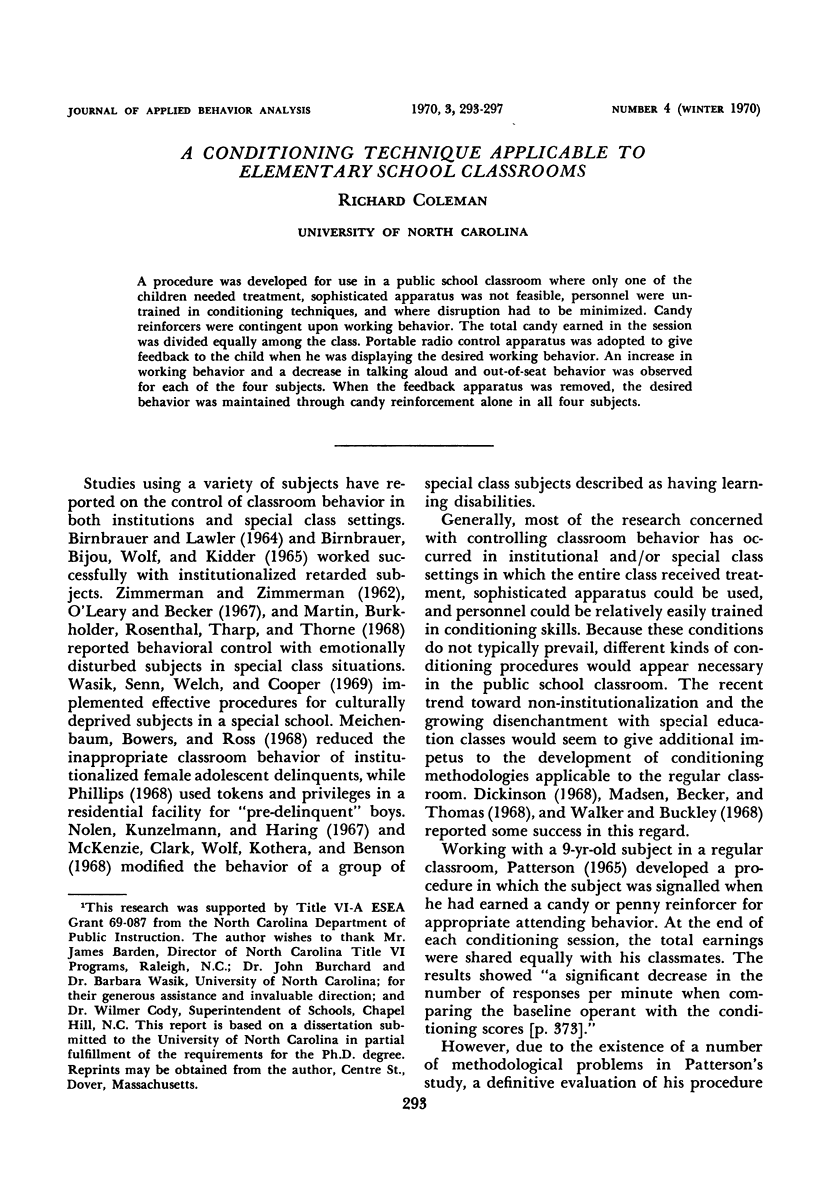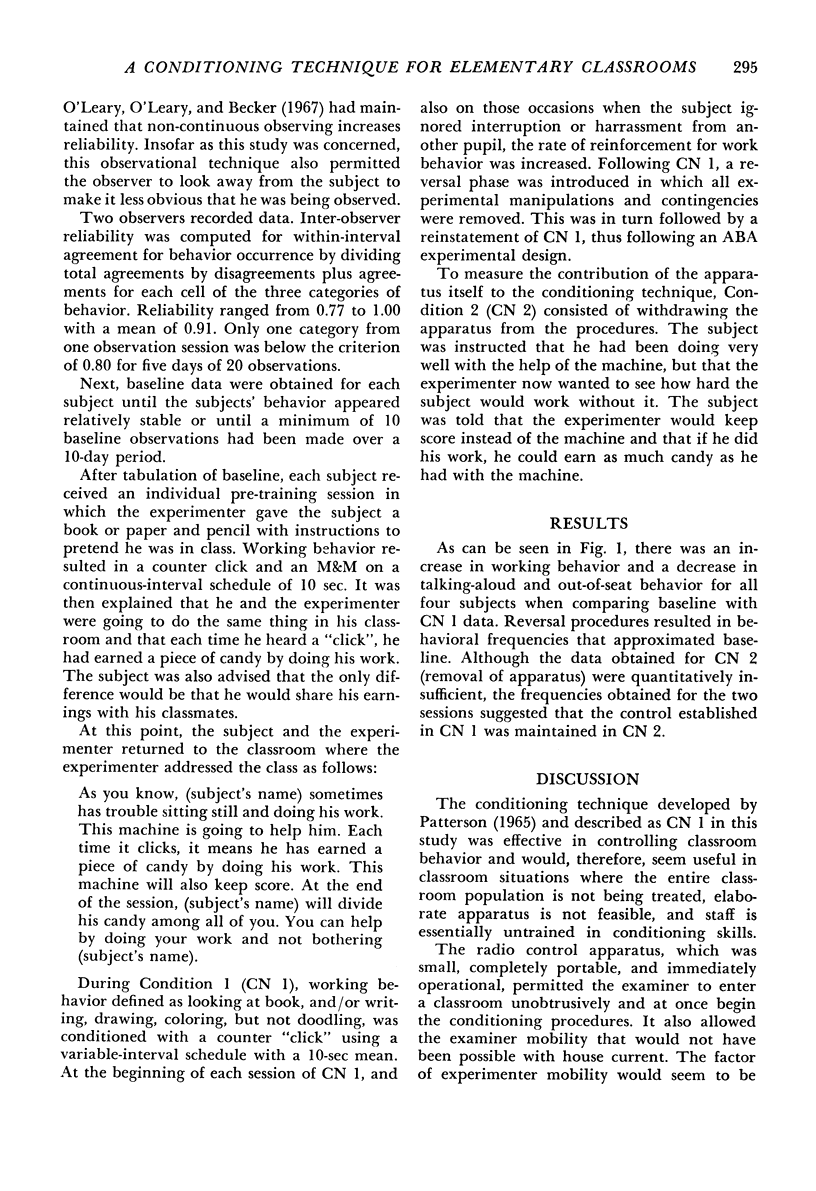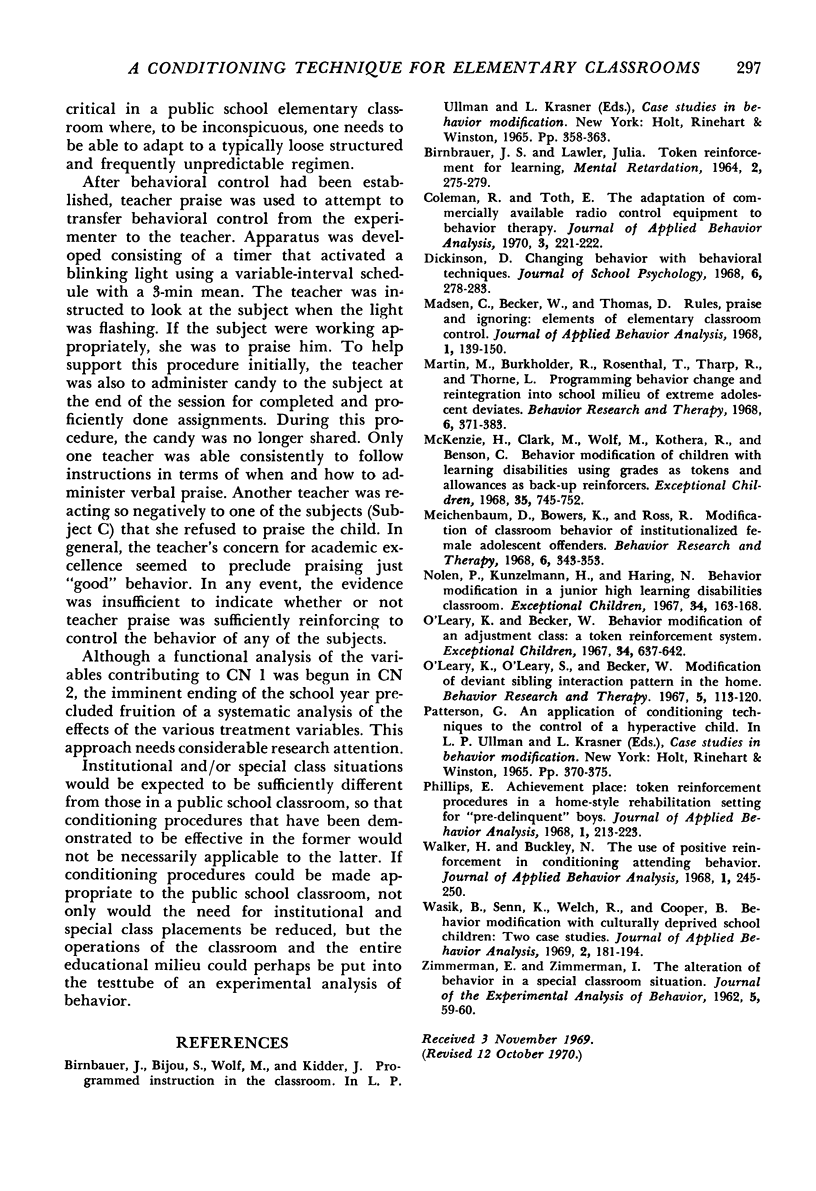Abstract
A procedure was developed for use in a public school classroom where only one of the children needed treatment, sophisticated apparatus was not feasible, personnel were untrained in conditioning techniques, and where disruption had to be minimized. Candy reinforcers were contingent upon working behavior. The total candy earned in the session was divided equally among the class. Portable radio control apparatus was adopted to give feedback to the child when he was displaying the desired working behavior. An increase in working behavior and a decrease in talking aloud and out-of-seat behavior was observed for each of the four subjects. When the feedback apparatus was removed, the desired behavior was maintained through candy reinforcement alone in all four subjects.
Full text
PDF




Selected References
These references are in PubMed. This may not be the complete list of references from this article.
- BIRNBRAUER J. S., LAWLER J. TOKEN REINFORCEMENT FOR LEARNING. Ment Retard. 1964 Oct;2(5):275–279. [PubMed] [Google Scholar]
- Coleman R., Toth E. The adaptation of commercially available radio control equipment to behavior therapy. J Appl Behav Anal. 1970 Fall;3(3):221–222. doi: 10.1901/jaba.1970.3-221. [DOI] [PMC free article] [PubMed] [Google Scholar]
- Madsen C. H., Becker W. C., Thomas D. R. Rules, praise, and ignoring: elements of elementary classroom control. J Appl Behav Anal. 1968 Summer;1(2):139–150. doi: 10.1901/jaba.1968.1-139. [DOI] [PMC free article] [PubMed] [Google Scholar]
- Martin M., Burkholder R., Rosenthal T. L., Tharp R. G., Thorne G. L. Programming behavior change and reintegration into school milieux of extreme adolescent deviates. Behav Res Ther. 1968 Aug;6(3):371–383. doi: 10.1016/0005-7967(68)90070-3. [DOI] [PubMed] [Google Scholar]
- McKenzie H. S., Clark M., Wolf M. M., Kothera R., Benson C. Behavior modification of children with learning disabilities using grades as tokens and allowances as back up reinforcers. Except Child. 1968 Summer;34(10):745–752. [PubMed] [Google Scholar]
- Meichenbaum D. H., Bowers K. S., Ross R. R. Modiciation of classroom behavior of institutionalized female adolescent offenders. Behav Res Ther. 1968 Aug;6(3):343–353. doi: 10.1016/0005-7967(68)90067-3. [DOI] [PubMed] [Google Scholar]
- Nolen P. A., Kunzelmann H. P., Haring N. G. Behavioral modification in a junior high learning disabilities classroom. Except Child. 1967 Nov;34(3):163–168. [PubMed] [Google Scholar]
- O'Leary K. D., Becker W. C. Behavior modification of an adjustment class: a token reinforcement program. Except Child. 1967 May;33(9):637–642. [PubMed] [Google Scholar]
- Phillips E. L. Achievement Place: token reinforcement procedures in a home-style rehabilitation setting for "pre-delinquent" boys. J Appl Behav Anal. 1968 Fall;1(3):213–223. doi: 10.1901/jaba.1968.1-213. [DOI] [PMC free article] [PubMed] [Google Scholar]
- Walker H. M., Buckley N. K. The use of positive reinforcement in conditioning attending behavior. J Appl Behav Anal. 1968 Fall;1(3):245–250. doi: 10.1901/jaba.1968.1-245. [DOI] [PMC free article] [PubMed] [Google Scholar]
- Wasik B. H., Senn K., Welch R. H., Cooper B. R. Behavior modification with culturally deprived school children: two case studies. J Appl Behav Anal. 1969 Fall;2(3):181–194. doi: 10.1901/jaba.1969.2-181. [DOI] [PMC free article] [PubMed] [Google Scholar]
- Zimmerman E. H., Zimmerman J. The alteration of behavior in a special classroom situation. J Exp Anal Behav. 1962 Jan;5(1):59–60. doi: 10.1901/jeab.1962.5-59. [DOI] [PMC free article] [PubMed] [Google Scholar]


